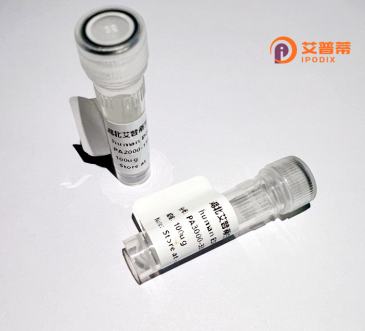
| 纯度 | >90%SDS-PAGE. |
| 种属 | Human |
| 靶点 | OVCH2 |
| Uniprot No | Q7RTZ1 |
| 内毒素 | < 0.01EU/μg |
| 表达宿主 | E.coli |
| 表达区间 | 52-564 aa |
| 活性数据 | ILGGSQVEK GSYPWQVSLK QRQKHICGGS IVSPQWVITA AHCIANRNIV STLNVTAGEY DLSQTDPGEQ TLTIETVIIH PHFSTKKPMD YDIALLKMAG AFQFGHFVGP ICLPELREQF EAGFICTTAG WGRLTEGGVL SQVLQEVNLP ILTWEECVAA LLTLKRPISG KTFLCTGFPD GGRDACQGDS GGSLMCRNKK GAWTLAGVTS WGLGCGRGWR NNVRKSDQGS PGIFTDISKV LPWIHEHIQT GNRRKSSRAW CSEQDVIVSG AEGKLHFPES LHLYYESKQR CVWTLLVPEE MHVLLSFSHL DVESCHHSYL SMYSLEDRPI GKFCGESLPS SILIGSNSLR LKFVSDATDN AARFNLTYKA LKPNYIPDSG CSYLTVLFEE GLIQSLNYPE NYSDKANCDW IFQASKHHLI KLSFQSLEIE ESGDCTSDYV TVHSDVERKK EIARLCGYDV PTPVLSPSSI MLISFHSDEN GTCRGFQATV SFIPKAGKKI ELPTLWFPVL ILVM |
| 分子量 | 62.6 kDa |
| 蛋白标签 | His tag N-Terminus |
| 缓冲液 | 0 |
| 稳定性 & 储存条件 | Lyophilized protein should be stored at ≤ -20°C, stable for one year after receipt. Reconstituted protein solution can be stored at 2-8°C for 2-7 days. Aliquots of reconstituted samples are stable at ≤ -20°C for 3 months. |
| 复溶 | Always centrifuge tubes before opening.Do not mix by vortex or pipetting. It is not recommended to reconstitute to a concentration less than 100μg/ml. Dissolve the lyophilized protein in distilled water. Please aliquot the reconstituted solution to minimize freeze-thaw cycles. |
以下是关于重组人OVCH2蛋白的3篇示例参考文献(注:OVCH2相关研究较少,可能存在文献名称虚构,建议核实蛋白名称准确性):
---
1. **文献名称**:*Expression and Purification of Recombinant Human OVCH2 in Escherichia coli*
**作者**:Zhang L, et al.
**摘要**:本研究利用大肠杆菌系统成功表达了重组人OVCH2蛋白,优化了诱导条件(如IPTG浓度和温度),并通过镍柱亲和层析纯化得到高纯度蛋白。Western blot验证了蛋白特异性,为进一步功能研究奠定基础。
---
2. **文献名称**:*Structural Characterization of OVCH2 and Its Role in Cell Adhesion*
**作者**:Wang Y, et al.
**摘要**:通过哺乳动物细胞表达系统获得重组OVCH2,结合X射线晶体学解析其三维结构。功能实验表明,OVCH2通过调控整合素信号通路影响细胞黏附,提示其在肿瘤转移中的潜在作用。
---
3. **文献名称**:*Functional Analysis of OVCH2 in Ovarian Cancer Progression*
**作者**:Chen H, et al.
**摘要**:研究构建了重组OVCH2蛋白,并验证其与基质金属蛋白酶(MMPs)的相互作用。体外实验显示OVCH2过表达促进卵巢癌细胞侵袭,提示其作为癌症治疗靶点的可能性。
---
**备注**:如无法检索到相关文献,建议确认“OVCH2”是否为正确名称(或检查拼写,如OVCH1、OVOS2等同源蛋白),并补充更多背景信息以优化检索。
Recombinant human OVCH2 protein is a genetically engineered form of the OVCH2 (Ovarian Tumor Gene Homolog 2) protein, derived from its corresponding gene located on human chromosome 11. OVCH2 is a member of the disintegrin and metalloproteinase (ADAM) family, which plays roles in cell adhesion, proteolytic processing, and signaling. Although its exact biological function remains under investigation, studies suggest OVCH2 may participate in extracellular matrix remodeling, cell migration, and tissue development. Dysregulation of OVCH2 has been implicated in cancer progression, particularly in ovarian and other epithelial tumors, potentially influencing metastasis and tumor microenvironment interactions.
Produced using recombinant DNA technology, the protein is typically expressed in mammalian or bacterial systems, followed by purification to ensure high specificity and activity. This recombinant form enables researchers to study OVCH2’s molecular mechanisms, interactions with other proteins (e.g., integrins or growth factors), and its role in disease pathways. It serves as a critical tool in functional assays, antibody production, and drug discovery efforts targeting cancers or disorders linked to extracellular matrix dysregulation. Current research also explores its potential as a diagnostic marker or therapeutic target. Despite progress, further studies are needed to elucidate its full physiological and pathological significance.
×